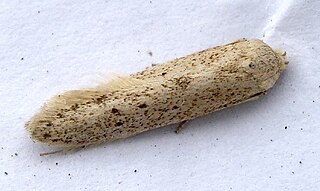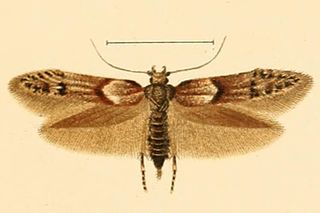
Quercus velutina, the black oak, is a species of oak in the red oak group, native and widespread in eastern and central North America. It is sometimes called the eastern black oak.

Fraxinus velutina, the velvet ash, Arizona ash or Modesto ash, is a species of Fraxinus native to southwestern North America, in the United States from southern California east to Texas, and in Mexico from northern Baja California east to Coahuila and Nuevo León.

Blastobasis is the type genus of the gelechioid moth family Blastobasidae; in some arrangements these are placed in the case-bearer family (Coleophoridae) as a subfamily. Within the Blastobasidae, the subfamily Blastobasinae has been established to distinguish the Blastobasis lineage from the group around Holcocera, but the delimitation is not yet well-resolved.

Tirumala hamata, the dark tiger, is a butterfly of the family Nymphalidae. It is distributed from the Philippines to Australia and Pacific oceanic islands such as Samoa. In Australia, the butterflies perform mass migrations to the south in some years. In April 1995, the butterfly made a rare migratory journey to New Zealand, coinciding with the appearance of Hypolimnas bolina on the islands.
Blastobasis balucis is a moth in the family Blastobasidae. It is found in Costa Rica.
Blastobasis echus is a moth in the family Blastobasidae. It is found in Costa Rica.
Blastobasis deliciolarum is a moth in the family Blastobasidae. It is found in Costa Rica.
Blastobasis dicionis is a moth in the family Blastobasidae. It is found in Costa Rica. Its forewings are 5–7 mm long and are brownish-grey intermixed with brownish-grey scales tipped with pale brownish-grey and pale brownish-grey scales. The hindwings are translucent pale brown, gradually darkening towards the apex.
Blastobasis acirfa is a moth in the family Blastobasidae. It is found in Kenya. The habitat consists of coastal lowlands and the western highlands.
Blastobasis elgonae is a moth in the family Blastobasidae. It is found in Kenya, where it is known from Mount Elgon in the western highlands.
Blastobasis indigesta is a moth in the family Blastobasidae. It is found in Zimbabwe.
Blastobasis divisus is a moth in the family Blastobasidae. It is found on Madeira.

Blastobasis exclusa is a moth in the family Blastobasidae. It is found on the Canary Islands.

Blastobasis helleri is a moth in the family Blastobasidae. It is found on the Canary Islands.

Blastobasis marmorosella is a moth in the family Blastobasidae. It is found on the Canary Islands, Madeira and in Portugal and Spain. This species has been accidentally introduced to Australia and New Zealand.

Blastobasis rubiginosella is a moth in the family Blastobasidae. It is found on the Canary Islands.
Blastobasis tridigitella is a moth in the family Blastobasidae. It is found in Thailand.
Blastobasis ianella is a moth in the family Blastobasidae. It is found in Thailand.
Blastobasis christou is a moth in the family Blastobasidae that is endemic to New Caledonia.







